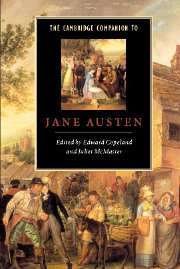Book contents
- Frontmatter
- 1 Chronology of Jane Austen's life
- 2 The professional woman writer
- 3 Northanger Abbey, Sense and Sensibility, Pride and Prejudice
- 4 Mansfield Park, Emma, Persuasion
- 5 The short fiction
- 6 The letters
- 7 Class
- 8 Money
- 9 Religion and politics
- 10 Style
- 11 Jane Austen and literary traditions
- 12 Austen cults and cultures
- 13 Further reading
- Index
12 - Austen cults and cultures
Published online by Cambridge University Press: 28 May 2006
- Frontmatter
- 1 Chronology of Jane Austen's life
- 2 The professional woman writer
- 3 Northanger Abbey, Sense and Sensibility, Pride and Prejudice
- 4 Mansfield Park, Emma, Persuasion
- 5 The short fiction
- 6 The letters
- 7 Class
- 8 Money
- 9 Religion and politics
- 10 Style
- 11 Jane Austen and literary traditions
- 12 Austen cults and cultures
- 13 Further reading
- Index
Summary
Ever since Henry James, early in this century, observed that a 'body of publishers, editors, illustrators, [and] producers of the pleasant twaddle of magazines' found 'their “dear”, our dear, everybody's dear, Jane so infinitely to their material purpose', two things have been abundantly clear: first, that Austen has been not a mere novelist about whom one might talk dispassionately, but a commercial phenomenon and a cultural figure, at once formidable and non-threatening; second, that many of Austen's most acute admirers have been unhappy with this extravagant popularity. An Austenian descendant himself, James aims his criticism not so much at Austen but at her faddish commodification by publishers and marketers. He had a point. Since 1832, Austen's six novels were available separately in the Standard Novels series published by Richard Bentley. But even though Bentley reprinted the novels at various times in the coming decades, joined by other printers once his copyrights expired, Austen's novels were hardly best sellers. Indeed, she remained an artist admired intensely by a few, such as George Lewes and Thomas Macaulay. 'Janeitism' - the self-consciously idolatrous enthusiasm for 'Jane' and every detail relative to her which James is alluding to - did not burgeon until the last two decades of the nineteenth century.
BIOGRAPHY
The dominant force in Jane Austen's life was her family, and her family has also been the dominant force in the study of her life. The major biographies of her for more than one hundred years after her death in 1817 were written by family members, and the biographies since then have relied largely on unpublished or obscurely published family manuscripts. Furthermore, the Austen family has been determined from the start to present its most famous member to the world as a figure of exemplary gentility and piety. Some five months after her death, Jane Austen was introduced to her readers as the author of her six novels, in the 'Biographical Notice' at the front of the volume containing her two posthumously published novels, Northanger Abbey and Persuasion, but this seven-page account by her favourite brother, Henry Austen, is in tone an obituary. Her life is depicted as faultless - 'She never uttered either a hasty, a silly, or a severe expression' (NA, P 6) - and the emphasis is upon the pious manner of her death.
- Type
- Chapter
- Information
- The Cambridge Companion to Jane Austen , pp. 211 - 226Publisher: Cambridge University PressPrint publication year: 1997
- 10
- Cited by



